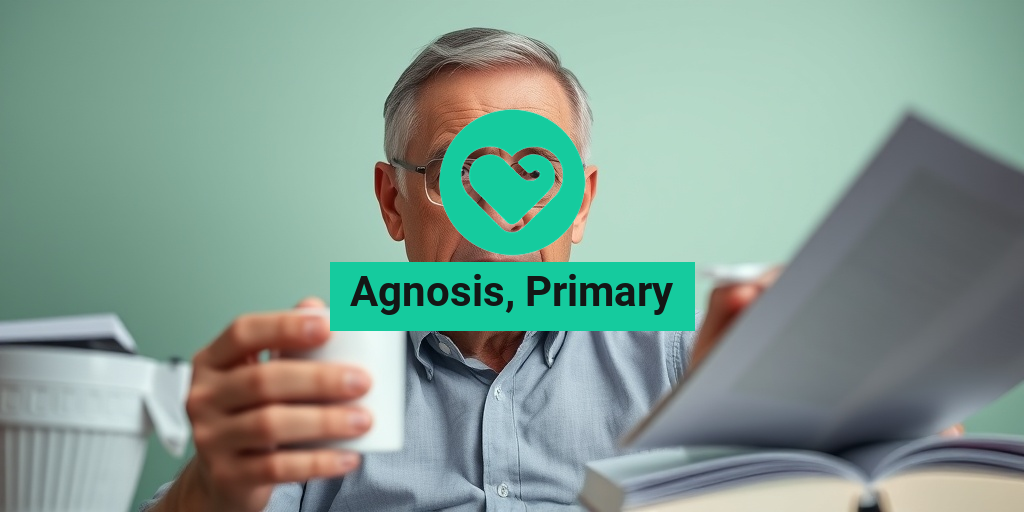What Is Agnosis?
Agnosis, particularly in the context of primary agnosia, refers to a neurological condition characterized by the inability to recognize or interpret sensory stimuli, despite having intact sensory organs. This condition can affect various senses, including vision, hearing, and touch, leading to significant challenges in daily life.
The term “agnosia” is derived from the Greek word “agnōsis,” meaning “lack of knowledge.” Individuals with agnosia may have difficulty identifying objects, faces, sounds, or even smells, which can be incredibly frustrating and isolating. It is essential to understand that agnosia is not a result of a lack of intelligence or memory; rather, it stems from damage to specific areas of the brain responsible for processing sensory information.
Types of Agnosia
There are several types of agnosia, each affecting different senses:
- Visual Agnosia: Individuals struggle to recognize objects or faces, even though their vision is intact.
- Auditory Agnosia: This type affects the ability to recognize sounds, including speech, despite normal hearing.
- Tactile Agnosia: People may find it challenging to identify objects by touch alone.
- Prosopagnosia: Also known as face blindness, this specific type of visual agnosia makes it difficult to recognize familiar faces.
Understanding the type of agnosia is crucial for effective treatment and management. Each type may require different therapeutic approaches, and early diagnosis can significantly improve outcomes.
Agnosis Symptoms
The symptoms of agnosia can vary widely depending on the type and severity of the condition. Here are some common symptoms associated with primary agnosia:
Visual Agnosia Symptoms
- Inability to recognize familiar objects: Individuals may not be able to identify everyday items, such as a cup or a pen.
- Difficulty recognizing faces: This can lead to social challenges, as individuals may struggle to identify friends and family.
- Confusion with colors and shapes: Some may have trouble distinguishing between different colors or shapes, even if their vision is clear.
Auditory Agnosia Symptoms
- Inability to recognize sounds: Individuals may not be able to identify common sounds, such as a ringing phone or a barking dog.
- Difficulty understanding speech: This can lead to challenges in communication, as individuals may misinterpret spoken words.
Tactile Agnosia Symptoms
- Inability to identify objects by touch: Individuals may struggle to recognize items without visual cues.
- Difficulty with spatial awareness: This can affect their ability to navigate their environment safely.
Emotional and Social Impact
The symptoms of agnosia can lead to significant emotional and social challenges. Individuals may experience feelings of frustration, anxiety, and isolation due to their inability to interact with the world as they once did. Support from family, friends, and healthcare professionals is crucial in helping individuals cope with these challenges.
If you or someone you know is experiencing symptoms of agnosia, it is essential to seek professional help. Early diagnosis and intervention can make a significant difference in managing the condition and improving quality of life. Resources like Yesil Health AI (yesilhealth.com) can provide valuable, evidence-based information and support for those affected by agnosia.
In conclusion, understanding agnosia and its symptoms is vital for those affected and their loved ones. By raising awareness and providing support, we can help individuals navigate the complexities of this condition and improve their overall well-being. 🌟

Agnosis Causes
Agnosis, particularly Primary Agnosis, is a neurological condition that affects an individual’s ability to recognize and interpret sensory information. Understanding the causes of agnosis is crucial for effective diagnosis and treatment. Here, we delve into the various factors that contribute to this condition.
Neurological Damage
One of the primary causes of agnosis is damage to specific areas of the brain responsible for processing sensory information. This damage can occur due to:
- Stroke: A stroke can disrupt blood flow to the brain, leading to cell death and impairing sensory processing.
- Traumatic Brain Injury (TBI): Injuries from accidents can cause localized damage, affecting the brain’s ability to recognize stimuli.
- Neurodegenerative Diseases: Conditions like Alzheimer’s disease or Parkinson’s disease can progressively damage brain areas involved in sensory recognition.
Genetic Factors
Research suggests that genetic predispositions may play a role in the development of agnosis. Certain inherited conditions can affect brain structure and function, leading to sensory processing issues. Genetic mutations that impact neural connectivity can also contribute to the onset of agnosis.
Developmental Disorders
Some individuals may experience agnosis as part of a broader developmental disorder. Conditions such as autism spectrum disorder (ASD) can affect sensory integration, leading to difficulties in recognizing and interpreting sensory information. Early diagnosis and intervention are crucial in these cases.
Environmental Influences
Environmental factors can also contribute to the development of agnosis. Exposure to toxins, infections during pregnancy, or complications at birth can impact brain development and function. For instance, maternal infections like rubella or cytomegalovirus (CMV) during pregnancy can lead to neurological issues in the child, including agnosis.
Agnosis Risk Factors
Identifying the risk factors associated with agnosis can help in early detection and intervention. While not everyone with these risk factors will develop agnosis, being aware of them can aid in understanding the condition better.
Age
Age is a significant risk factor for agnosis. Older adults are more susceptible to neurodegenerative diseases that can lead to agnosis. As the brain ages, the likelihood of experiencing strokes or other neurological issues increases, which can contribute to sensory processing disorders.
Family History
A family history of neurological disorders can increase the risk of developing agnosis. If close relatives have experienced similar conditions, it may indicate a genetic predisposition that could affect sensory processing abilities.
Pre-existing Medical Conditions
Individuals with certain medical conditions are at a higher risk for developing agnosis. These include:
- Diabetes: Chronic diabetes can lead to complications affecting the brain and nervous system.
- Hypertension: High blood pressure can increase the risk of stroke, which may result in agnosis.
- Cardiovascular Diseases: Conditions affecting heart health can impact blood flow to the brain, leading to neurological issues.
Substance Abuse
Substance abuse, particularly of alcohol and recreational drugs, can have detrimental effects on brain health. Long-term abuse can lead to cognitive impairments and increase the risk of developing agnosis due to brain damage.
Social Isolation
Social isolation and lack of mental stimulation can also be risk factors for agnosis. Engaging in social activities and cognitive challenges is essential for maintaining brain health. A lack of interaction can lead to cognitive decline, increasing the risk of sensory processing disorders.
In conclusion, understanding the causes and risk factors associated with Primary Agnosis is vital for early diagnosis and intervention. By recognizing these elements, individuals and healthcare providers can work together to manage and potentially mitigate the effects of this condition. 🌟

Agnosis Diagnosis
Agnosis, particularly Primary Agnosia, refers to a condition where an individual is unable to recognize objects, people, sounds, shapes, or smells despite having intact sensory functions. This neurological disorder can significantly impact daily life, making accurate diagnosis crucial for effective management. Understanding the diagnostic process is essential for both patients and healthcare providers.
Understanding the Symptoms
The first step in diagnosing agnosia is recognizing its symptoms. Individuals with primary agnosia may experience:
- Visual Agnosia: Difficulty recognizing familiar objects or faces.
- Auditory Agnosia: Inability to identify sounds, such as music or spoken words.
- Tactile Agnosia: Trouble recognizing objects through touch.
- Spatial Agnosia: Difficulty understanding spatial relationships between objects.
These symptoms can vary widely among individuals, making it essential for healthcare professionals to conduct thorough assessments.
Diagnostic Procedures
Diagnosing primary agnosia typically involves a combination of clinical evaluations and neuropsychological tests. Here are some common steps in the diagnostic process:
- Medical History Review: The healthcare provider will gather information about the patient’s medical history, including any neurological conditions, injuries, or psychological issues.
- Neurological Examination: A comprehensive neurological exam helps assess cognitive functions, reflexes, and sensory responses.
- Neuropsychological Testing: Specialized tests evaluate the patient’s ability to recognize objects, sounds, and other sensory inputs. These tests can help pinpoint the type of agnosia present.
- Brain Imaging: Techniques such as MRI or CT scans may be used to identify any structural abnormalities in the brain that could contribute to agnosia.
Accurate diagnosis is vital, as it guides treatment options and helps in understanding the underlying causes of the condition. 🧠
Agnosis Treatment Options
Once diagnosed, the next step is exploring treatment options for primary agnosia. While there is no one-size-fits-all solution, various approaches can help manage symptoms and improve quality of life.
Rehabilitation Therapy
Rehabilitation therapy is often the cornerstone of treatment for individuals with agnosia. This may include:
- Occupational Therapy: Focuses on helping individuals regain skills needed for daily living, such as recognizing objects and navigating their environment.
- Speech Therapy: Particularly beneficial for those with auditory agnosia, helping patients improve their communication skills and sound recognition.
- Cognitive Rehabilitation: Aims to enhance cognitive functions through targeted exercises and activities that stimulate recognition and memory.
Medications
While there are no specific medications for agnosia, treating underlying conditions or associated symptoms may involve:
- Antidepressants: If the patient experiences depression or anxiety related to their condition.
- Antipsychotics: In cases where agnosia is linked to severe psychological disorders.
Medications should always be prescribed and monitored by a healthcare professional to ensure safety and efficacy.
Supportive Strategies
In addition to formal treatments, supportive strategies can play a significant role in managing agnosia:
- Education and Awareness: Educating family members and caregivers about agnosia can foster a supportive environment.
- Assistive Technology: Tools such as apps and devices designed to aid recognition can be beneficial.
- Support Groups: Connecting with others facing similar challenges can provide emotional support and practical advice.
Overall, a multidisciplinary approach involving healthcare providers, therapists, and family members is essential for effectively managing primary agnosia. With the right support and treatment, individuals can lead fulfilling lives despite their challenges. 🌟

Agnosis Management Strategies
Agnosis, particularly Primary Agnosis, refers to a condition where individuals struggle to recognize familiar objects, people, or sounds despite having intact sensory functions. Managing this condition can be challenging, but with the right strategies, individuals can improve their quality of life. Here are some effective management strategies:
1. Cognitive Rehabilitation Therapy
Cognitive rehabilitation therapy (CRT) is a structured program designed to help individuals regain cognitive functions. This therapy focuses on enhancing memory, attention, and problem-solving skills. Techniques may include:
- Memory exercises: Engaging in activities that stimulate memory recall.
- Attention training: Practicing tasks that require sustained focus.
- Problem-solving tasks: Working through puzzles or real-life scenarios to improve cognitive flexibility.
2. Occupational Therapy
Occupational therapy (OT) plays a crucial role in helping individuals with agnosis adapt to daily life. An occupational therapist can assist in:
- Developing coping strategies: Finding ways to manage daily tasks despite recognition difficulties.
- Creating a supportive environment: Modifying home or workspaces to reduce confusion and enhance safety.
- Enhancing life skills: Teaching practical skills that promote independence.
3. Support Groups and Counseling
Connecting with others who understand the challenges of agnosis can be incredibly beneficial. Support groups provide a platform for sharing experiences and coping strategies. Additionally, counseling can help individuals and their families navigate the emotional aspects of living with agnosis.
4. Use of Technology
In today’s digital age, technology can be a powerful ally in managing agnosis. Various apps and devices can assist with recognition and memory. For instance:
- Smartphone apps: Applications that help identify objects or people through image recognition.
- Wearable devices: Gadgets that provide reminders and alerts for daily tasks.
5. Medication Management
While there is no specific medication for agnosis, underlying conditions that contribute to cognitive impairment may be treated with medication. Consulting with a healthcare provider is essential to determine the best course of action.
Agnosis Prognosis and Outlook
The prognosis for individuals with Primary Agnosis can vary significantly based on several factors, including the underlying cause, the severity of the condition, and the effectiveness of management strategies. Understanding the outlook can help individuals and families prepare for the journey ahead.
1. Factors Influencing Prognosis
Several factors can influence the prognosis of agnosis:
- Underlying health conditions: Conditions such as stroke, traumatic brain injury, or neurodegenerative diseases can impact recovery.
- Age: Younger individuals may have a better chance of recovery compared to older adults.
- Early intervention: Prompt diagnosis and management can lead to improved outcomes.
2. Potential for Improvement
Many individuals with agnosis can experience improvement over time, especially with consistent therapy and support. Cognitive rehabilitation and occupational therapy can lead to significant gains in recognition abilities and daily functioning. However, it’s important to set realistic expectations and celebrate small victories along the way. 🌟
3. Long-term Outlook
While some individuals may achieve substantial recovery, others may continue to face challenges with recognition. Ongoing support from healthcare professionals, family, and friends is crucial in navigating these challenges. The focus should be on enhancing quality of life and maintaining independence as much as possible.
4. Importance of a Supportive Network
A strong support network can make a significant difference in the lives of those with agnosis. Family members, friends, and caregivers play a vital role in providing emotional support and practical assistance. Encouraging open communication and understanding can foster a positive environment for individuals facing this condition.
In conclusion, while the journey with agnosis can be complex, effective management strategies and a supportive outlook can lead to improved quality of life. By focusing on rehabilitation, utilizing technology, and fostering a strong support system, individuals can navigate the challenges of agnosis with resilience and hope. 💪

Frequently Asked Questions about Agnosis, Primary
What is Agnosis, Primary?
Agnosis, Primary refers to a condition characterized by the inability to recognize or interpret sensory stimuli, despite having intact sensory organs. This condition can significantly impact daily functioning and quality of life.
What are the symptoms of Agnosis, Primary?
- Difficulty recognizing familiar objects or faces
- Challenges in interpreting sensory information
- Confusion in understanding spatial relationships
- Potential issues with communication and social interactions
What causes Agnosis, Primary?
The causes of Agnosis, Primary can vary widely and may include neurological disorders, brain injuries, or developmental conditions. It is essential to consult a healthcare professional for a proper diagnosis and understanding of the underlying causes.
How is Agnosis, Primary diagnosed?
Diagnosis typically involves a comprehensive evaluation by a neurologist or psychologist, including:
- Medical history review
- Neurological examinations
- Cognitive assessments
- Imaging studies, such as MRI or CT scans
What treatments are available for Agnosis, Primary?
Treatment options for Agnosis, Primary may include:
- Occupational therapy to improve daily functioning
- Cognitive rehabilitation to enhance recognition skills
- Supportive therapies, such as speech or language therapy
Each treatment plan should be tailored to the individual’s specific needs and challenges.
Can Agnosis, Primary be prevented?
While not all cases of Agnosis, Primary can be prevented, maintaining overall brain health through a balanced diet, regular exercise, and mental stimulation may help reduce the risk of developing related conditions.
Is there support available for individuals with Agnosis, Primary?
Yes! There are various support groups and resources available for individuals and families affected by Agnosis, Primary. Connecting with others who share similar experiences can provide emotional support and practical advice. 🌟
Where can I find more information about Agnosis, Primary?
For more information, consider visiting reputable health websites, consulting healthcare professionals, or exploring literature on cognitive disorders. Staying informed is key to managing Agnosis, Primary effectively.




